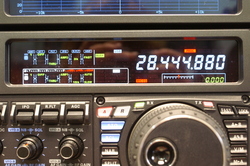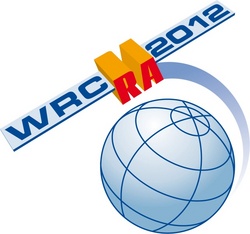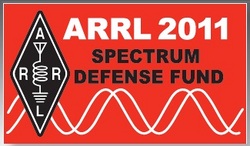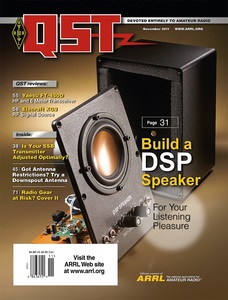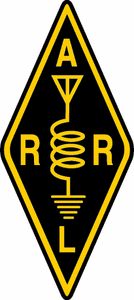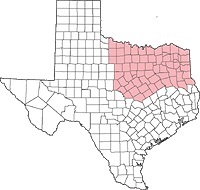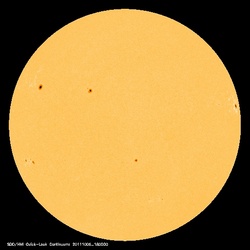 October 6, 2011 John E. Ross, KD8IDJ, Editor
| |||||||||
+ Available on ARRL Audio News. + On the Air: 10 Meters Is Hot!
For the past few days, the solar flux has been hovering around 130. While this is down from a peak of 190 -- the highest we've seen in Solar Cycle 24 -- just 11 days ago, the higher HF bands are definitely feeling the effect. Higher solar flux levels can mean higher sunspot levels and this is good news for radio amateurs, especially Technicians. The 10 meter band is the only HF band where Techs have phone privileges. "Techs can get use their voice privileges from 28.300-28.500 MHz," explained W1AW Station Manager Joe Carcia, NJ1Q. "If you don't have your own HF rig, find someone in your local radio club who does or call your Elmer. Without a doubt, you don't want to miss this opening. Who knows how long it will last or when it will come back? So get on the air while you can and experience the magic of 10 meters." The solar flux is predicted to hit 140 on October 12 and stay at that level for almost a week. Read more here. + WRC-12: European Proposal for Amateur Secondary MF Allocation Clears Important Hurdle In preparation for the 2012 World Radiocommunication Conference (WRC-12), the CEPT Project Team C approved a draft European Common Proposal (ECP) for an 8 kHz-wide band between 472 and 480 kHz at its September meeting. The draft ECP will now go to CEPT's Conference Preparatory Group for formal ratification in November. This breakthrough -- at the 11th and final meeting of the project team -- occurred with the submission by the UK's Ofcom of an RSGB-drafted compromise ECP proposal that is also supported by France and Sweden.
Agenda Item 1.23 calls for WRC-12 delegations to consider an allocation of about 15 kHz in parts of the band 415-526.5 kHz to the Amateur Service on a secondary basis, taking into account the need to protect existing services. "While an 8 kHz allocation does not fully meet our objective of 15 kHz, having a European Common Proposal for an amateur allocation is a major step toward possibly achieving one at WRC-12," said ARRL Chief Executive Officer David Sumner, K1ZZ. According to Colin Thomas, G3PSM, the prospect of an agreed CEPT position is good progress, representing a 48 country block vote going into next year's WRC-12. "It needs to be noted that the draft ECP comes with significant caveats to avoid interference to the primary user, as well as the existing secondary user services," he explained. "These are the maritime and aeronautical radionavigation services, respectively. As secondary users, we would also not be afforded any protection. It should be acknowledged that we have had support from a number of Region 1 IARU Member-Societies in getting to this position." Thomas is the CEPT Coordinator for this agenda item. + Every Radio Amateur Knows that Spectrum Defense Matters
The second edition for 2011 of Spectrum Defense Matters -- a newsletter aimed at keeping ARRL members updated on issues related to the protection of Amateur Radio frequencies -- was recently released on the ARRL website. This newsletter covers both domestic and international topics related to the Amateur Radio spectrum. Your financial support is vital to continue the ARRL's work to protect your operating privileges. You can help protect these privileges by contributing generously to the 2011 ARRL Spectrum Defense Fund. Defending spectrum means protecting the way each of us chooses to enjoy Amateur Radio. It is important to have VHF/UHF allocations when radio amateurs are called upon to provide support during communications emergencies. But Amateur Radio is primarily a personal radio service where licensees have great latitude to develop their skills, experiment to broaden their knowledge base, serve their communities and to simply have fun. Click here to read about some of the Spectrum Defense items featured in this issue of Spectrum Defense Matters. + Check Out the November Issue of QST The November issue of QST is jam-packed with all sorts of things that today's Amateur Radio operator needs. From product reviews to experiments to contesting, this issue of QST has something for just about everyone. Now that the colder months are here, thoughts turn to tinkering in the shack. If your radio doesn't come with digital signal processing capability, why not build a DSP speaker? DSP cuts out the unwanted noise and gives you only the signal you want to hear, adapting to changes in the signal's conditions. Allen Baker, KG4JJH, offers a schematic for a DSP speaker in his article "Build Your Own DSP Speaker." In designing a modern-day antenna, Dave Holdeman, N9XU, recalls a "plumber's delight" from his Novice days in his article "A 160 or 80 Meter Downspout Vertical." Build a self-contained multi-oscillator that allows for convenient and precise SSB transmitter adjustment after you read "A Four Tone SSB Test Generator" by Dave Lyndon, AK4AA.
If you have an Android smartphone, you probably have a couple of Amateur Radio-related apps on it. But how do you know which one is right for you? William F. Vartorella, KJ4ORX, presents a handy guide in "Android Apps for the Amateur." With so many insurance options available, it can get confusing when looking for the best coverage for your ham gear. In his article "Homeowners Insurance and Your Radio Gear," Ray Fallen, ND8L, discusses how to purchase insurance for your station. ARRL Emergency Preparedness Manager Mike Corey, W5MPC, takes a look at the Yaesu FT-450D HF and 6 meter transceiver in this month's Product Review. He says that this rig "adds a standard internal antenna tuner, new CW filter bandwidths and several ergonomic upgrades to the original FT-450. These refinements make a popular, low-cost transceiver even better." ARRL Test Engineer Bob Allison, WB1GCM, checks out the Elecraft XG3 RF signal source: "The Elecraft XG3 is a compact, accurate signal source with a variety of uses in the Amateur Radio station or at the workbench." Of course, there are the usual columns you know and expect in the November QST: Happenings, Hints & Kinks, The Doctor Is IN, How's DX, Technical Correspondence, Vintage Radio and more. Look for your November issue in your mailbox. QST is the official journal of ARRL, the national association for Amateur Radio. QST is just one of the many benefits of ARRL membership. To join or renew your ARRL membership, please visit the ARRL web page. At the Workbench: The Deadline for the Third ARRL Homebrew Challenge Is Approaching
The ARRL has sponsored two Homebrew Challenges in the past, designed to test our members' design and construction skills by making useful amateur gear at low cost -- and sharing their results with our members. Our first ARRL Homebrew Challenge, announced in QST for August 2006, required the construction of a 40 meter, 5 W voice and CW transceiver built for less than $50 of new parts. The Second Homebrew Challenge, announced in February 2009, resulted in a number of creative designs of low cost 50 W linear amplifiers to follow the transceiver -- two for about $30, as well as a multiband amplifier with many features for somewhat more. The deadline for the Third Homebrew Challenge is Tuesday, November 1. Read more here. + Public Service: Nominations Now Open for the George Hart Distinguished Service Award The George Hart Distinguished Service Award may be presented by the Board of Directors to the ARRL member whose service to the ARRL's Field Organization is of the most exemplary nature. The Distinguished Service Award is named in honor of George Hart, W1NJM, long-time Communications Manager at ARRL Headquarters and chief developer of the National Traffic System. Read more here. ARRL in Action: What Have We Been Up to Lately?
This feature is a concise monthly update of some of the things that the ARRL is doing on behalf of its members. This installment -- which covers the month of September -- takes a look at how the ARRL briefed members of the White House staff on Amateur Radio's capabilities during emergencies, how the ARRL Lab is investigating power line noise, the upcoming Director elections in the ARRL's Atlantic, Delta and Midwest Divisions, the search for a new ARRL Treasurer, recognizing radio amateurs for technical excellence, reports from the Official Observer Desk and more. Read more here. + Section News: New Section Manager Appointed in North Texas
Effective Wednesday, October 5, the ARRL North Texas Section has a new Section Manager. Jay Urish, W5GM, of Flower Mound, stepped down for personal reasons. He has served as North Texas Section Manager since April 2009, and was re-elected to a second term in April 2011. Walt Mayfield, KE5SOO, of Krum, has been appointed the North Texas Section Manager, as of October 5, to fulfill the present term of office. ARRL Membership and Volunteer Programs Manager Dave Patton, NN1N, made the appointment in consultation with West Gulf Division Director David Woolweaver, K5RAV. Mayfield has served as the North Texas Section Emergency Coordinator and is the president of the Denton County Amateur Radio Association. Mayfield's appointment continues through March 31, 2013. Committee Notes: Changes to ARRL Ethics and Elections Committee There is a change in the composition of the ARRL Ethics and Elections Committee. President Kay Craigie, N3KN, has accepted the resignation of Southeastern Division Director Greg Sarratt, W4OZK, from the committee, thanking him for his service as chairman for the past nine months. Roanoke Division Director Dennis Bodson, W4PWF, will serve on the committee for the remainder of the one-year term. Committee member Tom Frenaye, K1KI, Director of the New England Division, will serve as chairman. Pacific Division Director Bob Vallio, W6RGG, also serves on the committee. Sarratt will continue to serve as Director of the ARRL's Southeastern Division. Solar Update
Tad "I wish the Sun would hide its head" Cook, K7RA, reports: The sunspot excitement continues, with photos of the Sun showing more and more spots. The average daily sunspot numbers for the week were about the same as the previous week, increasing from 96.1 to 96.7, while the average daily solar flux dropped from 155.5 to 132.6. Our three month moving average of sunspot numbers puts us into activity levels last seen in mid-2004. The latest NOAA/USAF forecast shows solar flux at 125 on October 6-7, 130 on October 8-12, 125 on October 13 and 110 on October 14-16. The planetary A index prediction shows 18 for October 6, 10 on October 7-8, 8 on October 9 and 5 on October 10-27. Look for more information on the ARRL website on Friday, October 7. For more information concerning radio propagation, visit the ARRL Technical Information Service Propagation page. This week's "Tad Cookism" is brought to you by Yellowcard's October Nights. + ARRL Recognizes: Robert Miller, KE6F , Wins September QST Cover Plaque Award The winner of the QST Cover Plaque Award for September is Robert Miller, KE6F , for his article "Yet Another Crystal Calibrator -- The YACC 1-2-3. " Congratulations Robert! The QST Cover Plaque award -- given to the author or authors of the best article in each issue -- is determined by a vote of ARRL members on the QST Cover Plaque Poll Web page . Cast a ballot for your favorite article in the October issue today. This Week on the Radio This week:
Next week:
All dates, unless otherwise stated, are UTC. See the ARRL Contest Branch page, the ARRL Contest Update and the WA7BNM Contest Calendar for more information. Looking for a Special Event station? Be sure to check out the ARRL Special Event Stations Web page. Upcoming ARRL Section, State and Division Conventions and Events
To find a convention or hamfest near you, click here. ARRL -- Your One-Stop Resource for Amateur Radio News and Information Join or Renew Today! ARRL membership includes QST, Amateur Radio's most popular and informative journal, delivered to your mailbox each month. Subscribe to NCJ -- the National Contest Journal. Published bi-monthly, features articles by top contesters, letters, hints, statistics, scores, NA Sprint and QSO Parties. Subscribe to QEX -- A Forum for Communications Experimenters. Published bi-monthly, features technical articles, construction projects, columns and other items of interest to radio amateurs and communications professionals. Free of charge to ARRL members: Subscribe to the ARES E-Letter (monthly public service and emergency communications news), the ARRL Contest Update (bi-weekly contest newsletter), Division and Section news alerts -- and much more! Find us on Facebook. Follow us on Twitter. ARRL offers a wide array of products to enhance your enjoyment of Amateur Radio Donate to the fund of your choice -- support programs not funded by member dues! Click here to advertise in this newsletter. | |||||||||
